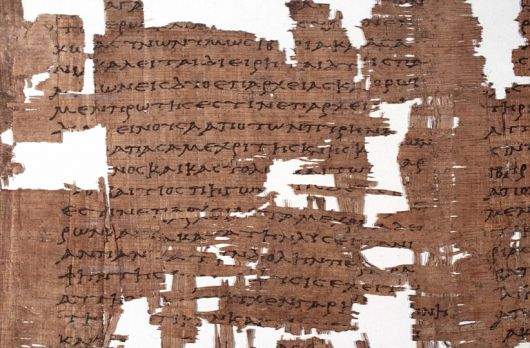Papyrus of Artemidorus fake: Turin prosecutor's investigation ends after five years
The Papyrus of Artemidorus, that is, the papyrus thought to be an original from the first century B.C. and intended to be attributed to the geographer Artemidorus of Ephesus, is in fact a nineteenth-century forgery: this is the final outcome of the Turin Public Prosecutor’s Office investigation, made public by prosecutor Armando Spataro a few days before his retirement (this was an investigation that had been going on for years, since 2013 to be exact, and to which he was particularly attached). As part of the investigation, the papyrus was analyzed by experts who focused on the materials and ascertained that it is a post-1st century B.C. artifact: it is probably a 19th-century forgery attributable to the forger Kostantinos Simonidis (Simi, 1820 - Alexandria, 1890?), famous for his skill in forging ancient Greek documents.
In particular, analysis by technicians has shown that the inks used to trace the text are very different from those used in antiquity, and there is also speculation that the papyrus was placed on top of a galvanized wire mesh in order to subject it to the action of acids (a treatment that would have left traces of zinc on the papyrus).
“The certainty of the forgery,” Spataro said, “is abundantly proven, at least on the basis of serious, precise and concordant circumstantial elements. It was deemed unnecessary, therefore, to order a technical consultancy, especially since the costs of this could not be justified, given the extinction of the crime due to the lapse of the statute of limitations.” The document had been purchased in 2004 by the Compagnia di San Paolo for the sum of 2 million and 750 thousand euros: for the magistrates it was fraud, a crime for which the merchant Serop Simonian (who sold the document to the Compagnia di San Paolo) was under investigation and who, however, fourteen years after the facts, will not be punished as the statute of limitations has passed.
The investigation had started in 2013 from a complaint by the well-known scholar Luciano Canfora, a classical philologist and historian, who had long suspected the artifact’s falsity (another important scholar, Salvatore Settis, an archaeologist almost Canfora’s age and, like the latter, a normalist, had instead come out in favor), so much so that he also published a book on the subject. The papyrus was supposed to be displayed in 2012 at the Egyptian Museum in Turin, which nevertheless kept it “hidden” for quite some time precisely because of doubts about its authenticity, and it was finally displayed with a notice informing the public that very heavy doubts were hanging over the work, precisely.
Canfora had relied on historical elements: according to the philologist, the language used in the text attributed to Artemidorus was far from that used at the time, and there would have been some elements in the text that a Greek geographer of the first century B.C. could not have known because they were more modern. It was Canfora himself who advanced the name of Simonidis (about whom, however, there is no certainty). The querelle had been going on for many years, involved several scholars and often went beyond the confines of scholarly publications, as several newspapers intervened in the debate with articles siding for or against the authenticity of the papyrus, signed by many of the protagonists in the dispute.
“The crime is time-barred,” commented Byzantinist Silvia Ronchey in Repubblica , “but the redemption of the scholars and brave officials who denounced remains.” She adds, “Luciano Canfora’s more than a decade-long battle to prove the falsity of the so-called papyrus of Artemidorus had become, for those who knew its obvious terms and the less obvious background, a gigantic symbol. Such by now will remain in the history of studies, and not only: in that of culture, and also, perhaps, of politics; assuming that a distinction can be made between the two, political and cultural engagement.”
 |
| Papyrus of Artemidorus fake: Turin prosecutor's investigation ends after five years |
Warning: the translation into English of the original Italian article was created using automatic tools. We undertake to review all articles, but we do not guarantee the total absence of inaccuracies in the translation due to the program. You can find the original by clicking on the ITA button. If you find any mistake,please contact us.




























